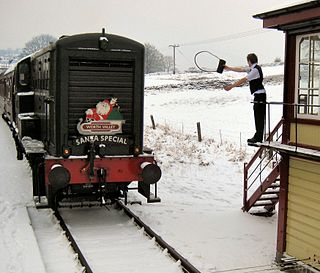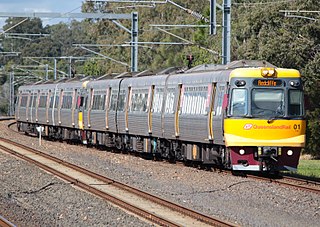
Railway signalling is a system used to direct railway traffic and keep trains clear of each other at all times. Trains move on fixed rails, making them uniquely susceptible to collision. This susceptibility is exacerbated by the enormous weight and inertia of a train, which makes it difficult to quickly stop when encountering an obstacle. In the UK, the Regulation of Railways Act 1889 introduced a series of requirements on matters such as the implementation of interlocked block signalling and other safety measures as a direct result of the Armagh rail disaster in that year.

In railway signalling, a token is a physical object which a train driver is required to have or see before entering onto a particular section of single track. The token is clearly endorsed with the names of the section it belongs to. A token system is more commonly used for single lines because of the greater risk of collision in the event of a mistake being made by a signaller or traincrew, than on double lines.
Dispatchers are communications personnel responsible for receiving and transmitting pure and reliable messages, tracking vehicles and equipment, and recording other important information. A number of organizations, including police and fire departments, emergency medical services, motorcycle couriers, taxicab providers, trucking companies, railroads, and public utility companies, use dispatchers to relay information and coordinate their operations. Essentially, the dispatcher is the "conductor" of the force, and is responsible for the direction of all units within it.

Centralized traffic control (CTC) is a form of railway signalling that originated in North America. CTC consolidates train routing decisions that were previously carried out by local signal operators or the train crews themselves. The system consists of a centralized train dispatcher's office that controls railroad interlockings and traffic flows in portions of the rail system designated as CTC territory. One hallmark of CTC is a control panel with a graphical depiction of the railroad. On this panel, the dispatcher can keep track of trains' locations across the territory that the dispatcher controls. Larger railroads may have multiple dispatcher's offices and even multiple dispatchers for each operating division. These offices are usually located near the busiest yards or stations, and their operational qualities can be compared to air traffic towers.

Radio Electronic Token Block is a system of railway signalling used in the United Kingdom. It is a development of the physical token system for controlling traffic on single lines.

The Iowa Interstate Railroad is a Class II regional railroad operating in the central United States. The railroad is owned by Railroad Development Corporation of Pittsburgh, Pennsylvania.
Standards for North American railway signaling in the United States are issued by the Association of American Railroads (AAR), which is a trade association of the railroads of Canada, the USA, and Mexico. Their system is loosely based on practices developed in the United Kingdom during the early years of railway development. However, North American practice diverged from that of the United Kingdom due to different operating conditions and economic factors between the two regions. In Canada, the Canadian Rail Operating Rules (CROR) are approved by the Minister of Transport under the authority of the Railway Safety Act. Each railway company or transit authority in Canada issues its own CROR rulebook with special instructions peculiar to each individual property. Among the distinctions are:

Signalling block systems enable the safe and efficient operation of railways by preventing collisions between trains. The basic principle is that a route is broken up into a series of blocks, only one train may occupy a block at a time, and that the blocks are sized to allow a train to stop within them. This ensures that a train always has time to stop before reaching another train on the same line. A block system is referred to as the method of working in the UK, method of operation in the US and safeworking in Australia.
Direct traffic control (DTC) is a system for authorizing track occupancy used on some railroads instead of or in addition to signals. It is known as "direct" traffic control because the train dispatcher gives track authority directly to the train crew via radio, as opposed to through wayside personnel via telephone or telegraph, as in train orders.

The Puget Sound and Pacific Railroad operates over 150 miles of track serving the U.S. State of Washington, and is headquartered in Centralia, Washington where interchanges with the BNSF Railway and Union Pacific Railroad are made.

Positive train control (PTC) is a system of functional requirements for monitoring and controlling train movements and is a type of train protection system. The term stems from control engineering. The train is only allowed to move in case of positive movement allowance. It generally improves the safety of railway traffic.
The La Junta Subdivision is a railway line owned, maintained and operated by the BNSF Railway. The line stretches for 395 miles across the south-central and southwestern parts of Kansas and the southeastern part of Colorado. The line branches off from the Emporia Subdivision at Ellinor, Kansas, and runs through Newton, Hutchinson, Dodge City and Garden City, all within the state of Kansas. The line connects with Boise City Subdivision at Las Animas Junction in Las Animas, Colorado, which connects it further to La Junta, Colorado.

Automatic block signaling (ABS) is a railroad communications system that consists of a series of signals that divide a railway line into a series of sections, or "blocks". The system controls the movement of trains between the blocks using automatic signals. ABS operation is designed to allow trains operating in the same direction to follow each other in a safe manner without risk of rear-end collision. The introduction of ABS reduced railways' costs and increased their capacity. Older manual block systems required human operators. The automatic operation comes from the system's ability to detect whether blocks are occupied or otherwise obstructed, and to convey that information to approaching trains. The system operates without any outside intervention, unlike more modern traffic control systems that require external control to establish a flow of traffic.
Dark territory is a term used in the North American railroad industry to describe a section of running track not controlled by signals. Train movements in dark territory were previously handled by timetable and train order operation, but since the widespread adoption of two way radio communications these have been replaced by track warrants and direct traffic control, with train dispatchers managing train movements directly. Today most dark territory consists of lightly used secondary branch lines and industrial tracks with speeds ranging between 25 miles per hour (40 km/h) and 40 miles per hour (64 km/h); however, there do exist a small minority of main lines that fall into the category.
The CSX Plymouth Subdivision is a freight railroad line in the U.S. state of Michigan. It connects the Plymouth Diamond at milepost CH 24.5 to Grand Rapids at CH 148.1, passing through the Lansing metropolitan area en route. Other towns served include Brighton, Howell, Williamston, Grand Ledge, and Lake Odessa. Operationally, it is part of the CSX Chicago Division, dispatched from Calumet City, IL.
The Callahan Subdivision is a CSX Transportation railroad subdivision within the Jacksonville Division on the former Seaboard Air Line Railroad. The sub extends northward 20 miles from Baldwin, Florida, where the Jacksonville Terminal Subdivision's S Line and Tallahassee Subdivision meet just north of Baldwin Yard, a classification yard. According to Jacksonville Division Timetable Number 4 published in 2005, the sub runs from milepost SM 0.18 to milepost SM 20.0, where it joins the Nahunta Subdivision, a former Atlantic Coast Line Railroad, in Callahan, Florida. The line serves as a bypass to Jacksonville.
The BNSF Avard Subdivision runs 177 miles (285 km) of track between Tulsa, Oklahoma, starting at milepost (MP) 425.2, to Avard, Oklahoma, MP 602, where it meets the BNSF Panhandle Sub.














